|
|
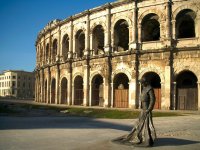
The arena at Nîmes.
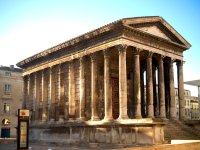
The Maison Carree
(square house) was a Roman temple from the 1st Century BC.
(It's also a bus stop).
|
No better way to
start off our second week than with another trip to see
some Roman antiquities. This time our destination took us
into the department of Gard, which is technically not part
of Provence, to see the city of Nîmes. Serving as
the capital for yet another Cletic tribe, the town earned
its name from a nearby spring called Nemansus. The Romans
liked the fact that Nîmes was located on the principal
trade route between Italy and Spain, so decided to call
it their own. The transition was peaceful and Nîmes
flourished as a Roman city replete with villas, baths, temples,
and even a coliseum. Nîmes survived the years of strife
that saw other towns destroyed and prospered as a trading
center. The industrial revolution turned the city into a
center for the textile industry in France, where it specialized
in silk and cotton fabrics. A specific durable blue cotton
fabric became well-known as de Nîmes (from
Nîmes), and when Levi Strauss ran across it in California
in the mid-1800’s, well, it became even more famous.
It was early morning
on a Sunday and not much was open, so we sat in a café
next to the arena in Nîmes sipping café
au lait. The interior of arena has been fully renovated
and is used for bullfights (an import from Spain) in the
summer months and concerts year round. It is equipped
with an inflatable roof for the winter months. After the
fall of the Roman Empire, people began moving into the
arena to live. At its peak, over 2,000 people lived in
200 houses inside the arena.
|
|
|
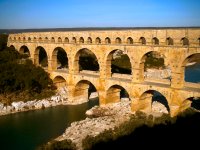
The magnificent
Pont du Gard.
|
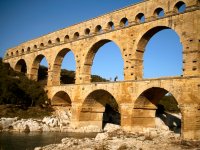
A view up from the
river Gard.
|
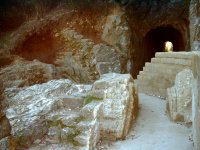
The end of the aqueduct
with the original channel turning off to the left once it
exits.
|
|
|
Eventually the Nemansus
spring near Nîmes couldn’t supply enough water for
the burgeoning city and the Romans were forced to look for
another source. They decided to import water from another
spring some 30 miles away and built an aqueduct across the
landscape. To cross the river Gard, they constructed the
magnificent Pont du Gard. The structure served as both an
aqueduct, water flowed through a covered channel at the
top, and a bridge. It’s amazing to think they used stone
blocks weighing up to 12 tons to build it. It is truly an
engineering marvel and pictures don’t do it justice.
|
|
|
|
D had seen some
nice pictures of Uzès in his hiking book, so we
swung by after our visit to the Pont du Gard with the
primary objective of getting something to eat. This is,
of course, no small task after the prescribed hours of
lunchtime in Provence. Uzès is known as the “city
of towers” for its six large towers that project from
the town’s medieval skyline. It will never be called the
“city of restaurants”. We searched without success until
we finally came across a café that was willing
to give us a plate of cold cuts with stale bread. To cap
off our fine meal, we visited the town biscuiterie
where we invested in some homemade cookies and candies.
When it comes to sweets in France, you can pretty much
bank on the fact that nothing is as good as it looks.
Though our brief stay was less than enjoyable, Uzès
is a very picturesque town and warrants inclusion on any
itinerary that brings you to the area.
|
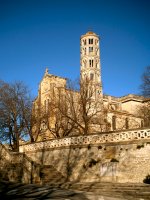
One of the towers in Uzès,
|
|
|
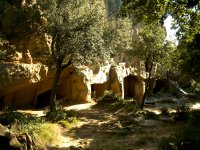
The troglodyte
site at Calès.
| 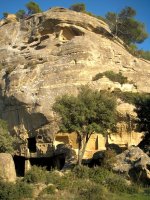
More of the caves
at Calès.
|
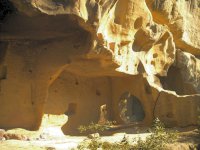
The interior of
one of the chambers carved into the sandstone.
|
|
|
Although we spent
a lot of time walking around Uzès looking for a place
to eat, we hadn’t gone for an official hike for several
days. We headed off just down the road from Eygalières
to start a hike that would take us by the site at Calès
near the town of Lamanon along the Durance. There is a large
outcropping of sandstone at Calès that had been home
to a Neolithic troglodyte tribe who had carved homes into
the soft faces of the cliffs. Similar to sites we had seen
by the Anasazi in Arizona, these people used logs jutting
from the stone as stairs to move from one dwelling to the
other. It is reported that up to 150 families lived here
at its peak.
|
|
|
|
Following the Sorgue, a tributary
of the Rhône, up toward the Vaucluse Plateau and the
white-capped Mont Ventoux, one comes to the town of Fontaine
de Vaucluse. Fontaine for the spring that made
it famous and Vaucluse from the Latin Vallis
Clause or “closed valley”, complements of the Romans.
Aside from being a stop for seemingly every tourist bus,
Fontaine is also known mainly for water and paper. Starting
with the first mill in 1522, Fontaine used the force of
the Sorgue to become a center for papermaking. Rags were
pulped between grinding stones powered by water wheels,
pressed, and dried to form a medieval version of paper.
The last paper mill closed in 1968.
Fontaine is also rather famous for
having hosted the Italian poet Petrarch (Francesco Petrarca)
from 1337-1357. While attending mass in Avignon one day,
Petrarch caught sight of a woman named Laura. Although they
never met, she became the inspiration for a number of poems
on Petrarch’s unrequited love and eventually lamenting her
death. While there are theories on the identity of Laura,
it has never been established, and Petrarch’s love poems
became world renowned for their poignancy. They even prompted
Giacomo Casanova to visit Fontaine in 1790 to pay homage
to the poet. |
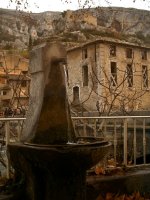
A fountain in Fontaine
with an old paper mill and a 15th century castle built by
the Bishops of Cavaillon.
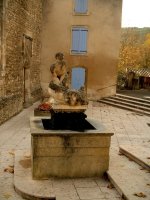
Another fountain
near the town's church.
|
|
|
| 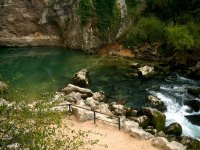
The spring at
Fontaine to Vaucluse.
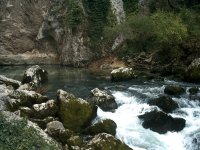
Another view of
the origin of the Sorgue.
|
Tracing the Sorgue upstream for about
a mile out of town, one comes to the real reason people
visit Fontaine de Vaucluse – la source. At the
base of a 700 ft cliff sits a pool of emerald green water
from which rushes forth the Sorgue at a rate of 165 billion
gallons per year, making it one of the largest springs in
the world. At peak flows, the spring captures rain from
the Vaucluse Plateau and snow melt from Mont Ventoux as
well as other nearby mountains. In summer, the level of
the spring can fall low enough to reveal the mouth of a
cave at the base of a cliff. As early as 1878, divers have
tried to explore the subterranean formations looking for
the bottom of the spring. Even Jacques Cousteau gave it
a go. An expedition in 1985 used cameras to find the bottom
to be over 900 ft before moving off horizontally under the
plateau.
|
|
|
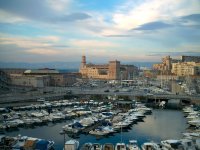
Fort St.-Jean at
the mouth of the harbor.
|
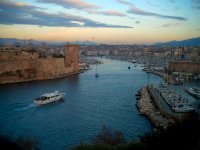
A view back
towards the Vieux Port with forts St.-Jean and St.-Nicholas
guarding the entrance.
|
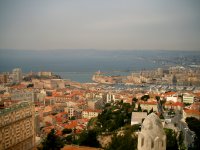
A view from Notre-Dame
de la Garde as storm clouds move in.
|
|
|
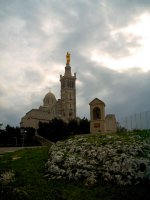
Notre-Dame de
la Garde perched over Marseille.
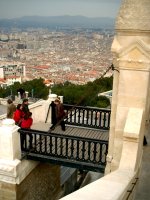
The unique church
has a draw bridge to keep out unwanted tourists.
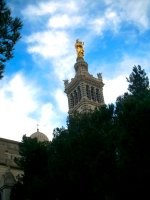
The 33 ft statue
of Mary and Jesus as skies begin to clear.
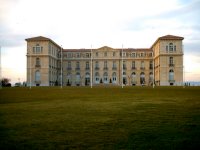
The Palais du
Pharos.
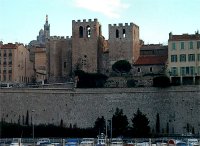
Abbaye de St.-Victor
with Notre-Dame de la Garde in the background.
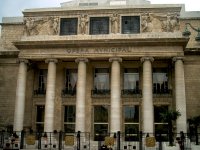
The famous opera
in Marseille.
|
Our New Years Eve
plans of going to a friend's home to celebrate had fallen
through because her children were both sick. So because
of our tight schedule this proved to be our only opportunity
to make the one hour drive to the coast and see Marseille.
We were going to celebrate at midnight there, maybe in a
café or restaurant, so there was no hurry in getting
to Marseille and we arrived just after noon.
The history of Marseille
is one that greatly influences Provence as well as France
as a whole. Around 600 BC, a group of Greeks arrived in
this region and were invited to a celebration to meet King
Nann, leader of the local Celtic tribe. It just so happened
that his daughter was to choose her husband at this celebration,
and when she laid eyes on the leader of the Greek party,
you can guess what happened. What woman can resist a Greek
sailor? As a wedding present, the king presented the couple
with a parcel of land called Lacydon. The Greeks founded
a major trading port at this site called Massalia which
flourished immediately by establishing trading routes along
the Mediterranean and African coasts. The city avoided the
fate of many others by aligning itself with Rome, and it
remained an independent republic for many years. Massalia
had a great influence on the interior of Provence where
inhabitants could sail their goods down the Rhône
to sell at or have sent from the large port. The Greeks
at Massalia introduced olives, figs, cherries, and nuts
into Provence. Marseille continued to benefit from the crusades
which used the port as a launching point and also the French
wars with Italy and Spain when pirated vessels from both
countries were brought there for looting. After the French
Revolution, when an insurgence of counter-revolutionists
in Paris threatened to retake the capital, 500 soldiers
marched from Marseille to help quell the uprising. The song
they sang while entering Paris, Roget de Lisle’s “Hymn to
the Army of the Rhein”, became a rallying cry for defenders
of the republic, and it was embraced as France’s national
anthem, La Marseillaise. The red, white and blue
French flag was also adopted from the flag of Martigues
on the outskirts of Marseille. Today Marseille is France’s
second largest city and the largest port on the Mediterranean.
It is best known for pastis, tourists, North Africans,
Olympique de Marseille (known locally as OM) and the milieu
(the French mafia).
We began our visit
by making the climb to the highest point of town to visit
the church of Notre-Dame de la Garde. The two-toned neo-Byzantine
church was built on the site of a 13th century chapel
and is topped by a 33 foot gilded statue of the Madonna.
The interior of the church is decorated with a nautical
theme as it was a place of worship and prayer for sailors
and their families in and around Marseille. It also served
as Nazi headquarters during World War II. It is the best
place to get a feel for the expanse of Marseille and gave
us a way to assess the distance between the sites we wanted
to see. Unfortunately, the original Greek settlement with
its old houses and twisting streets was blown up by the
Nazis. They left only three of the original buildings
that appealed to them, the opera being one. A rare occurrence
in Marseille, it began to rain, and weI ducked into the
church’s restaurant for an unusual lunch amid a mixture
of tourists and nuns.
D received a call
from his friend back in Cavaillion who decided to go ahead
with her New Years Eve dinner plans after all since her
sister had decided to visit. J had wanted to meet some
real-life French people, so we accepted the invitation
although it meant cutting our trip to Marseille short.
The rain had let up, so we made our way down to the Vieux
Port to see some the oldest parts of town. Our stroll
took us past the Abbaye de St.-Victor which, dating back
to the 5th century, was one of the first Christian structures
in the area and a launching point for missionaries to
spread Christianity to the rest of Provence. We made our
way down past the Fort St.-Nicholas, built by Louis XIV
to keep and eye on the ornery Marseillaise, to the Palais
du Pharos. Built by Napolean III and now used for concerts,
Pharos offers an excellent view back toward the old port.
Across the entrance to the port is the medieval fortress
of St.-Jean and the colossal neo-Byzantine Cathédrale
de la Nouvelle Major.
After some time in
the Christmas market, looking at some stores, and sipping
a pastis at an outside café while watching
the sun set over the harbor, it was time to head back for
our New Years soirée. |
|
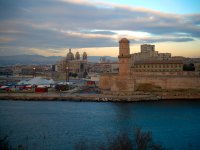
St.-Jean and Cathédrale
de la Nouvelle Major.
|
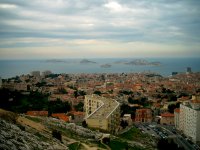
The islands off of Marseille. The
closest is home to the Château d'If, the prison
that held the Count of Monte Cristo.
|
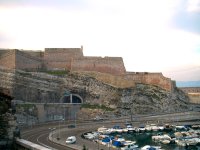
Fort St.-Nicholas
with the highway burrowed underneath.
|
|
|
|
Not wanting to drink
champagne on an empty stomach, we decided to grab a bite
to eat before we headed to the New Years Eve party. It was
almost 10pm and the only thing open was Bismilah’s Kebabs,
so we each scarfed down a kebab and went home to change
into some decent cloths. When we arrived at our friend’s
home, we were horrified to see the dinner table set for
what looked like to be a long meal (i.e., lots of different
kinds of knives and forks). The festivities got underway
with an assortment of appetizers including both green and
black tapanade (a Provençal olive paste),
courchette (zucchini) dip, caviar, and trout eggs,
all washed down with the first bottle of champagne. Things
moved on to an enormous platter of huîtres
(raw oysters), the traditional New Years Eve dish in France.
From the expression on our faces, our hosts thought we had
never seen raw oysters before. Living in New England, of
course, this was not the case. It was just that neither
of us cared for them very much and would rather eat them
cooked given the option. Our hosts shuddered at the thought
of cooked oysters and encouraged us to indulge. So with
the taste of trout eggs still fresh in our mouths, we did
our best with the oysters. Always the competitor, J refused
to be outdone by D, and we finally called it a draw after
four each.
Sometime during the
eating of the huîtres, we toasted the new
year at the stroke of midnight. Another French tradition
is that everyone calls one another immediately after midnight,
a custom obviously initiated by the France Telecom. So there
was a slight delay before the main course made it to the
table. Remembering a previous discussion, our hostess prepared
a heaping platter of cuisses de grenouille (frog
legs) especially for D and J. Having already been less than
enthused with the first few offerings, we mustered up all
our courage, piled a bunch on our plates while looking eager.
To our knowledge, it was the first time we had eaten an
amphibian, and we openly admit that they are actually pretty
good. Not unexpectedly, they taste like chicken but with
a light flavor of fish. There’s an amazing amount of meat
on those little guys, too. They were cooked in oil and garlic
and served with rice as well as a sausage dish from Réunion
Island plus a lot more wine. D was quite proud of his pile
of frog leg bones until he glanced over at J’s plate to
see a pile twice as large and her licking her fingers looking
for more.
|
It turned out to
be the birthday of one of our hosts, so there was even more
champagne and a birthday cake to polish off. When all was
said and done, it was a five hour meal and a fantastic experience
for both of us. Finally, at 3 am after a lot of food and
champagne, we thanked our gracious hosts and waddled to
the car. |
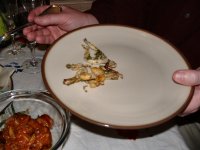
Look at the meat
on those hoppers.
|
|
|
|
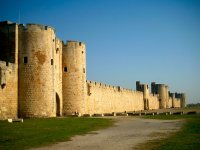
The beautiful city
walls of Aigues Mortes.
|
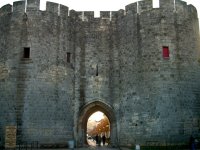
One of the main
gates to the city.
|
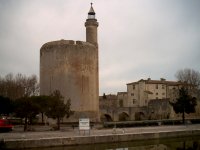
Tour Constance was a protestant prison.
|
|
|
The alarm rang awfully
early the next morning. As much as we would have liked to
sleep in, J was running out of days and it was now or never
to go to the Camargue. We rolled out of bed at 8 am, showered,
and headed off toward the Rhône. The Camargue is the
delta formed by the Rhône flowing into the Mediterranean
Sea. It’s sort of a marshy wetlands area famous for rice,
flamingos (in the summer), bulls, and white horses. Lower
in altitude and closer to the coast, the weather looked
to be nicer as well. Our first destination was Aigues Mortes,
which along with the Pont du Gard, and the theatre at Orange,
is on our list of top three things to see in Provence.
When Pope Innocent
IV beckoned the kings of Europe in 1245 to lead a crusade
to the Holy Land, King Louis IX was ready to answer the
call. The problem was that he had no land on the Mediterranean
coast with which to organize the fleet. At that time, the
French coast was under control of the German Empire and
the King of Aragon. Louis traded some land up north for
a parcel of mosquito-infested swampland known as “dead waters”
that had access to the sea. Louis built a beautifully laid
out grid city there called Aigues Mortes (dead waters) as
well as a road through the swamps connecting it to the mainland.
People weren’t exactly dying to move there, so he granted
special exemptions from taxes, duties, and tolls to attract
some inhabitants. Eventually he found enough volunteers
to lead the 7th Crusade with 100 ships and thousands of
men. He returned years later and immediately started organizing
his next crusade from which he was never to return. For
his efforts, he was canonized as Saint Louis and is celebrated
every August 25th with a feast.
Having never been
attacked, the city walls surrounding Aigues Moertes are
in immaculate condition. As I mentioned, the streets are
laid out in a perfect grid with each ending at a gate in
the city walls. The city now survives on tourism and the
salt trade. Large ponds of sea water are left to evaporate,
and the precipitated salt is packaged for export. No longer
directly on the coast due to the changing Rhône, a
canal connects it with the sea.
We spent some time
walking around town, although all but one street and the
main square was closed because it was New Years Day. We
found a quaint little restaurant and indulged in taureau
à la gardienne, a dish of rice and tender
bull meat in a wine sauce with olives. After strolling
around some more to work off lunch, we made our way to
our second destination in the Camargue. |
|
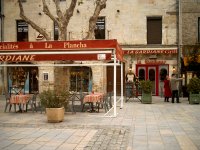
La Gardiane restaurant
on the town square.
|
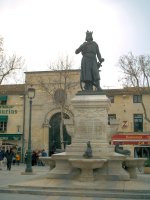
Statue of King
Louis IX.
|
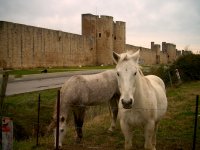
The Camargue is
famous for its white horses.
|
|
|
|
The town of Stes.-Maries-de-la-Mer
looks and feels like a seaside resort in Spain. Its crawling
with tourists, filled with shops and restaurants, and peppered
with crêpe, gauffre (waffle), and
ice cream stands (with exotic flavors like violet, lavender,
and toblerone). Legend has it that Mary Magdalene, Mary
Salome, and Mary Jacobe landed here in the “boat of Bethany”
after being set adrift from the Holy Land. For miraculously
surviving the ordeal, they were canonized (hence the name
of the town Saint Marys of the Sea). Along for the ride
was a slave named Sarah who is now the patron saint of gypsies.
Every year gypsies from all over Europe flock to the city
in what is known as the Pèlerinage des Gitans
to honor Sarah who is buried in the town’s church.
|
|
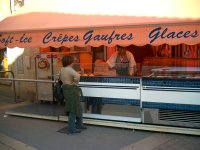
Goodies for sale
in Stes.-Maries-de-la-Mer.
|
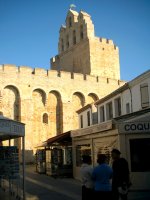
Church housing the tomb of Sarah.
|
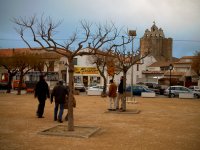
A leisurely game
of pétanque.
|
|
|
|
J’s last day saw
the onset of yet another cold mistral blowing
through the area, so it was left up to her as to what
she wanted to do. D was glad to find that she opted for
a brief hike in the nearby Tallgard, an area near Salon-de-Provence
that is known for its ancient terraces and bories. It
was a cold walk, but we pulled through and returned home
to pack, drink some wine, and say our goodbyes.
|
|
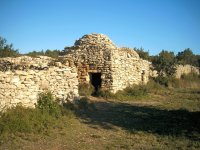
Bories were used
to provide shelter to shepherds.
|
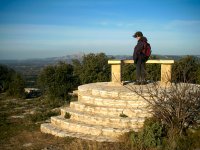
A windy overlook of the surrounding
landscape.
|
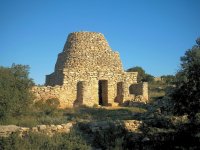
One of the more
interesting bories.
|
|
|
|
Copyright © 2005 JnDsTravelog.com. All rights reserved. |
|